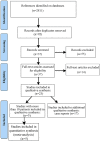The toxic effects of chloroquine and hydroxychloroquine on skeletal muscle: a systematic review and meta-analysis
- PMID: 33758324
- PMCID: PMC7988151
- DOI: 10.1038/s41598-021-86079-4
The toxic effects of chloroquine and hydroxychloroquine on skeletal muscle: a systematic review and meta-analysis
Abstract
The aim of this systematic review was to perform qualitative and quantitative analysis on the toxic effects of chloroquine (CQ) and hydroxychloroquine (HCQ) on skeletal muscles. We designed the study according to PRISMA guidelines. Studies for qualitative and quantitative analyses were selected according to the following inclusion criteria: English language; size of sample (> 5 patients), adult (> age of 18) patients, treated with CQ/HCQ for inflammatory diseases, and presenting and not presenting with toxic effects on skeletal muscles. We collected data published from 1990 to April 2020 using PubMed, Cochrane Library, EMBASE, and SciELO. Risk of bias for observational studies was assessed regarding the ROBIN-I scale. Studies with less than five patients (case reports) were selected for an additional qualitative analysis. We used the software Comprehensive Meta-Analysis at the confidence level of 0.05. We identified 23 studies for qualitative analysis (17 case-reports), and five studies were eligible for quantitative analysis. From case reports, 21 patients presented muscle weakness and confirmatory biopsy for CQ/HCQ induced myopathy. From observational studies, 37 patients out of 1,367 patients from five studies presented muscle weakness related to the use of CQ/HCQ, and 252 patients presented elevated levels of muscle enzymes (aldolase, creatine phosphokinase, and lactate dehydrogenase). Four studies presented data on 34 patients with confirmatory biopsy for drug-induced myopathy. No study presented randomized samples. The chronic use of CQ/HCQ may be a risk for drug-induced myopathy. There is substantiated need for proper randomized trials and controlled prospective studies needed to assess the clinical and subclinical stages of CQ/HCQ -induced muscle myopathy.
Conflict of interest statement
Dr. Marco Brotto is a founding partner of the Bioform Sciences LLC. All other authors declare no competing interests.
Figures




Similar articles
-
Chloroquine and Hydroxychloroquine for the Treatment of COVID-19: a Systematic Review and Meta-analysis.J Gen Intern Med. 2020 Nov;35(11):3308-3314. doi: 10.1007/s11606-020-06146-w. Epub 2020 Sep 3. J Gen Intern Med. 2020. PMID: 32885373 Free PMC article.
-
Chloroquine- and Hydroxychloroquine-Induced Cardiomyopathy: A Case Report and Brief Literature Review.Am J Clin Pathol. 2021 May 18;155(6):793-801. doi: 10.1093/ajcp/aqaa253. Am J Clin Pathol. 2021. PMID: 33316045 Free PMC article. Review.
-
Torsade de pointes associated with chloroquine, hydroxychloroquine, and azithromycin: a retrospective analysis of individual case safety reports from VigiBase.Eur J Clin Pharmacol. 2021 Oct;77(10):1513-1521. doi: 10.1007/s00228-021-03133-w. Epub 2021 May 3. Eur J Clin Pharmacol. 2021. PMID: 33938974 Free PMC article.
-
Efficacy and safety of chloroquine and hydroxychloroquine for treatment of COVID-19 patients-a systematic review and meta-analysis of randomized controlled trials.Am J Cardiovasc Dis. 2021 Feb 15;11(1):93-107. eCollection 2021. Am J Cardiovasc Dis. 2021. PMID: 33815925 Free PMC article. Review.
-
Chloroquine and Hydroxychloroquine Myopathy: Clinical Spectrum and Treatment Outcomes.Front Neurol. 2021 Feb 2;11:616075. doi: 10.3389/fneur.2020.616075. eCollection 2020. Front Neurol. 2021. PMID: 33603707 Free PMC article.
Cited by
-
Drug risks associated with sarcopenia: a real-world and GWAS study.BMC Pharmacol Toxicol. 2024 Nov 7;25(1):84. doi: 10.1186/s40360-024-00813-y. BMC Pharmacol Toxicol. 2024. PMID: 39511635 Free PMC article.
-
Review of Hydroxychloroquine Cardiotoxicity: Lessons From the COVID-19 Pandemic.Curr Heart Fail Rep. 2022 Dec;19(6):458-466. doi: 10.1007/s11897-022-00581-y. Epub 2022 Sep 27. Curr Heart Fail Rep. 2022. PMID: 36167917 Free PMC article. Review.
-
Drug-Induced Myopathies: A Comprehensive Review and Update.Biomedicines. 2024 Apr 30;12(5):987. doi: 10.3390/biomedicines12050987. Biomedicines. 2024. PMID: 38790948 Free PMC article. Review.
-
Chloroquine Causes Aging-like Changes in Diaphragm Neuromuscular Junction Morphology in Mice.Cells. 2025 Mar 7;14(6):390. doi: 10.3390/cells14060390. Cells. 2025. PMID: 40136639 Free PMC article.
-
PRMT5 mediates FoxO1 methylation and subcellular localization to regulate lipophagy in myogenic progenitors.Cell Rep. 2023 Nov 28;42(11):113329. doi: 10.1016/j.celrep.2023.113329. Epub 2023 Oct 25. Cell Rep. 2023. PMID: 37883229 Free PMC article.
References
-
- Rainsford KD, Parke AL, Clifford-Rashotte M, Kean WF. Therapy and pharmacological properties of hydroxychloroquine and chloroquine in treatment of systemic lupus erythematosus, rheumatoid arthritis and related diseases. Inflammopharmacology. 2015;23:231–269. doi: 10.1007/s10787-015-0239-y. - DOI - PubMed
Publication types
MeSH terms
Substances
Grants and funding
LinkOut - more resources
Full Text Sources
Other Literature Sources
Miscellaneous

